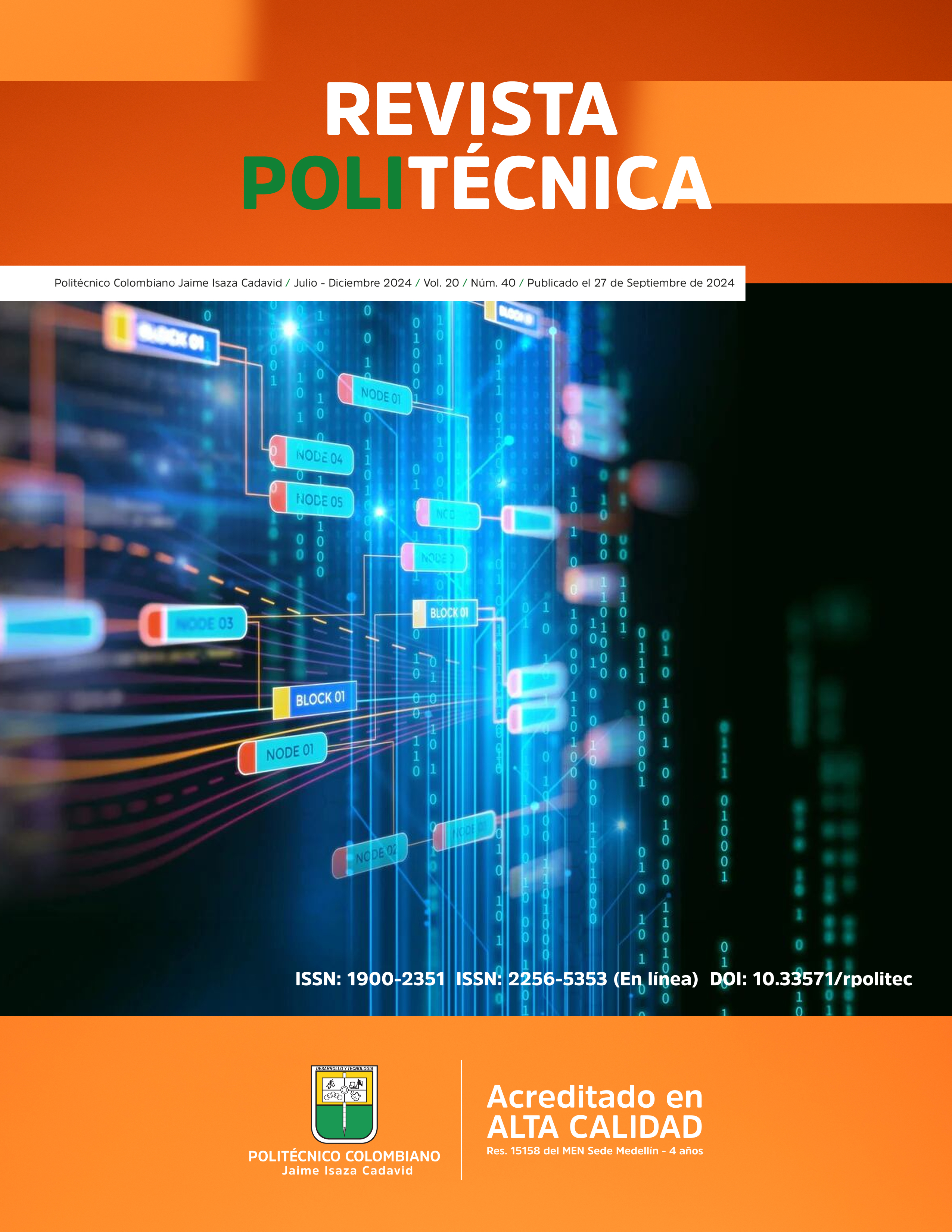ESTIMATION OF THE INFLUENCE OF VEHICULAR EMISSIONS ON THE CONCENTRATION OF PM2.5. MEDELLÍN, COLOMBIA
DOI:
https://doi.org/10.33571/rpolitec.v20n40a14Keywords:
Air, atmospheric pollution, vehicular emissions, fine particulate matter, Chemical characterization, contribution of sources PMF modelAbstract
This work allows us to demonstrate the influence of several sources on the emission of fine particulate matter (PM2.5) based on historical data from the city of Medellín, between 2009 and 2011. The complete analysis of hourly variations in the concentration of PM2.5 show that there is a clear seasonal behavior of the data, with the appearance of a clearly differentiated peak in the morning hours. This phenomenon is related to the influence of vehicle traffic and to the dispersion conditions of pollutants at the Valle de Aburrá, Colombia. A chemical analysis of the collected samples confirmed the influence of traffic on concentrations PM2.5. Finally, based on the PM2.5 characterization, the PMF model was applied to identify the sources of PM2.5 in three zones of the urban area with high mobility.
Article Metrics
Abstract: 2 PDF (Español (España)): 0PlumX metrics
References
WHO World Health Organization. 9 out of 10 people worldwide breathe polluted air, but more countries are taking action. [Online].; 2018. Acceso 2 de Mayo de 2018. Disponible en: https://www.who.int/news/item/02-05-2018-9-out-of-10-people-worldwide-breathe-polluted-air-but-more-countries-are-taking-action.
Correa M, Zuluaga C, Palacio C, Pérez J, Jiménez J. Acoplamiento de la libertad libre con el campo de vientos locales en una región tropical de topografía compleja. Caso de estudio: Valle de Aburrá, Antioquia, Colombia. Dyna. 2009; 76(150).
DANE. DANE. [Online]; 2019. Acceso 22 de Agostode 2019. Disponible en: https://www.dane.gov.co/files/censo2018/informacion-tecnica/presentaciones-territorio/190822-CNPV-presentacion-Antioquia-Valle-de-Aburra.pdf.
Instituto Colombiano Agustín Codazzi. Mapas habilitados. [Online].Acceso 12 de Febrero de 2023. Disponible en: https://igac.gov.co/catastro-multiproposito/mapa-de-habilitados.
AMVA. Acuerdo Metropolitano N° 04- Protocolo del Plan Operacional para Enfrentar Episodios de Contingencias Atmosféricas en la Jurisdicción del Área Metropolitana del Valle de Aburrá. Medellín. https://www.metropol.gov.co/ambiental/calidad-del-aire/Documents/POECA/Acuerdo-Metropolitano-04-de-2018-POECA.pdf. 2018.
Watson J. Protocol for applying and validating the CMB model for PM2,5 and VOC.Reno Nevada, United States. U.S. Environmental Protection Agency. 2004.
Gómez M, Saldarriaga J, Correa M, Posada E, Castrillon F. Modelación estadística de los aportes de las vías como fuentes de emisión a las partículas totales en suspensión según modelo MCF, zona centro de Medellín Antioquia - Colombia,2004. Dyna. 2007; 74(153 ).
US-EPA. Positive Matrix Factorization (PMF) 5.0 Fundamentals and User Guide. [Online]; 2014. Disponible en: https://www.epa.gov/sites/production/files/2015-02/documents/pmf_5.0_user_guide.pdf.
Gómez M, Posada E, Saldarriaga J, Correa M. Evaluación del impacto en la concentración del PM2,5 a partir del mejoramiento del combustible en la calidad del aire del Valle de Aburrá.; 2011.
AMVA , Politécnico Colombiano JIC , Universidad de Antioquia. Evaluación del impacto de la reducción del contenido de azufre en la gasolina en el Valle de Aburrá, Convenio AMVA 410 de 2011. https://www.metropol.gov.co/ambiental/calidad-del-aire/Biblioteca-aire/Combustibles/06-Evaluacion-reduccion-contenido-azufre-combustible-2011.pdf. 2011.
AMVA , Politécnico Colombiano Jaime Isaza Cadavid. Convenio 543 Caracterización PM2,5 en tres zonas del Valle de Aburrá. 2010.
Environmental Protection Agency - EPA. Air Emissions Modeling. [Online].; 2009.. Disponible en: https://www.epa.gov/air-emissions-modeling/speciate-2.
ICONTEC. Norma técnica colombiana NTC ISO/IEC 17025. http://www.saludcapital.gov.co/ctdlab/publicaciones/2015/norma%20tecnica%20colombiana%2017025.pdf. 2005.
Hand J, Malm W. Review of the Improve equation for estimating am-bient light extinction coefficients. Fort Collins, Colorado: Co-lorado State Univresity CIRA. http://vista.cira.colostate.edu/IMPROVE/Publications/GrayLit/016_IMPROVEeqReview/IMPROVEEquationReview.pdf.
Paatero P, Tapper U. Positive matrix factorization: a non-negative factor model with optimal utilization of error estimates of data values. Environmetric. 1994; 5(111-126).
AMVA. Calidad del Aire. Obtenido de Condiciones especiales del Valle de Aburrá. [Online].; 2019.. Disponible en: https://www.metropol.gov.co/ambientales/calidad-del-aire/generalidades/condiciones-especiales.
Bedoya J, Martínez E. Air quality in the Aburrá Valley Antioquia-Colombia. Dyna. 2009; 76(7-15).
UPB , AMVA , SIATA , UNAL , PCJIC. Plan Operacional para Enfrentar Episodios Críticos de Contaminación Atmosférica en el Valle de
Aburrá. [Online].; 2016.. Disponible en: https://www.metropol.gov.co/ambiental/calidad-del-aire/Biblioteca-aire/Informes-Periodo-Gestion-de-Episodios/Informe_Contingencia_Marzo_2016.pdf.
UPB , AMVA , SIATA , UNAL , PCJIC. Plan Operacional para Enfrentar Episodios Críticos de Contaminación Atmosférica en el Valle de Aburrá. Mede-llín. [Online].; 2016.. Disponible en: https://www.metropol.gov.co/ambiental/calidad-del-aire/Biblioteca-aire/Informes-Periodo-Gestion-de-Episodios/Informe_Contingencia_Marzo_2016.pdf.
MADS. Resolución 610 de 2010 de 24 de marzo de 2010. [Online].; 2010.. Disponible en: http://www.minambiente.gov.co/images/normativa/app/resoluciones/bf-Resoluci%C3%B3n%20610%20de%202010%20-%20Calidad%20del%20Aire.pdf.
Chow JC, Lowenthal DH, Chen LW, Wang X, Watson JG. Mass reconstruction methods for PM2.5: a review. Air Quality Atmosphere and Health. 2015; 8(3 ).
Song X, Polissar AV, Hopke PK. Sources of fine particle composition in the northeastern US. Atmospheric Environment. 2001; 35(31).
Almeida SM, Manousakas M, Diapouli E, Kertesz Z, Samek L, Hristova E, et al. Ambient particulate matter source apportionment using receptor modelling in European and Central Asia urban areas. Environmental Pollution. Environmental Pollution. 2020; 266.
Gómez D, Giné A, Sánchez PS. Antimony: A traffic-related element in the atmosphere of Buenos Aires. Environmental Monitoring. 2005; 7(12).
Almeida S M, Canha N, Freitas MC, Dung HM, Dionisio I. Air pollution at an urban traffic tunnel in Lisbon, Portugal-an INAA study. Air pollution at an urban traffic tunnel in Lisbon, Portugal -an INAA study. 2011; 69(11).
Diapouli E, Manousakas MI, Vratolis S, Pateraki S, Bairachtari KA, Querol X, et al. Estimation of natural source contributions to urban ambient air PM10 and PM2. 5 concentrations in southern Europe - Implications to compliance with limit values. Atmospheric Chemistry and Physics. 2017; 17(5).
Allen JO, Mayo PR, Hughes LS, Salmon LG, Cass GR. Emissions of size-segregated aerosols from on-road vehicles in the Caldecott Tunnel. Environmental Science and Technology. 2001; 35(27).
Manousakas M, Papaefthymiou H, Diapouli E, Migliori A, Karydas AG, Bogdanovic-Radovic I, et al. Assessment of PM2.5 sources and their corresponding level of uncertainty in a coastal urban area using EPA PMF 5.0 enhanced diagnostics. Science of the total environment. 2017; 574(155-164).
Kim E, Hopke PK, Edgerton ES. Source identification of atlanta aerosol by positive matrix factorization. Journal of the Air and Waste. 2003; 53(731-739).
Amato F, Pandolfi M, Escrig A, Querol X, Alastuey A, Pey J. Quantifying road dust resuspension in urban environment by Multilinear Engine: A comparison with PMF2. Atmos Environ. 2009; 43(17).
Downloads
Published
How to Cite
Issue
Section
License
Copyright (c) 2024 Miriam Gomez-Marin, Dora Luz Yepes-palacio, Enrique Posada-Restrepo, Carlos Alberto Hurtado-Castaño

This work is licensed under a Creative Commons Attribution-NonCommercial-ShareAlike 4.0 International License.


























